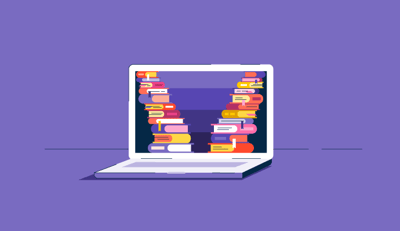July 19, 2018
 by Jordan Wahl / July 19, 2018
by Jordan Wahl / July 19, 2018
We live in the age of electronic everything. eCommerce, eBanking, eTickets, eGift Cards, eCigarettes, and the list goes on.
Why? Because people love the idea of doing everything from virtually anywhere on any device. With that being said, it’s no surprise that we’ve started revolutionizing the way we do just about everything.
What started as a way to make everyday activities easier has made its way to our leisure activities: reading being one that comes to my mind right away. We’ve introduced eBooks as a way of making one of America’s favorite pastimes that much easier.
Surprised? I’m not. But, what exactly is an eBook and what can it do? You’d think it’s what it sounds like, an electronic book. However, it’s a little more complicated than that.
To clear things up, I’m going to tell you all about eBooks:
When we’re through, you’ll know everything you need to know about eBooks, and then some.
So, let’s get to it.
If you look eBook up in the dictionary, you’d find the following:
Noun
Pretty straightforward. An electronic book; an eBook.
But here’s the thing: If an eBook is simply a book in a digital form that, technically, qualifies many things that aren’t actually eBooks. It also doesn’t truly define what makes an eBook an eBook. So what does?
An eBook is a non-editable, reflowable book that is converted to a digital format to be read on any digital device such as computer screens or mobile devices.
To have a better understanding of what an eBook really is, let’s take a look at the characteristics of an eBook.
For starters, eBooks are files that you can read on a digital device – a tablet, smartphone, computer, etc. But again, considering other files can be read on digital devices (i.e. word documents) eBooks have specific characteristics that differentiate them.
One distinct characteristic of an eBook: the text should not be editable. An eBook should always be converted into a format that ensures it’s uneditable. With thousands of people having access to it on digital devices, people could potentially change any content without the author’s permission. So, in order to qualify as an actual eBook, text should not be able to be changed in any way, just like a paperback book.
Another important characteristic is that true eBooks should be reflowable. This means that no matter what the size of the screen you’re viewing the eBook on, it will always fit your screen; text will remain formatted with line breaks and chapters and images will resize to fit the proportions of the device you’re reading on.
There is one exception though: PDFs. Considering PDFs can’t be edited, but they aren’t reflowable, they technically don’t qualify as eBooks according to the characteristics that differentiate eBooks. But with businesses taking advantage of the ease of PDF downloads and distribution, PDFs have become “unofficial” eBooks and are still widely used eBook formats.
If you were to search for eBook formats, you would come across quite a few options. Dozens actually. However, the likelihood of actually using many of these formats is pretty slim. To keep it simple for you, we are going to just take a look at the three that are known for their ease of use and ability to be used in a format that is widely distributed: EBUP, AZW, and PDF.
An EPUB, or electronic publication, is the most widely supported format and can be read on a variety of devices, including computers, smartphones, tablets, and most eReaders (except Kindles). EPUB files are reflowable, which make them true eBooks and easier to read on small devices.
AZW files were developed by Amazon for its Kindle eReaders. These files can store complex content like bookmarks, annotations, and highlights. But use of AZW files are limited to Kindles or devices with Kindle apps. Additively, they can only be accessed from the Amazon online bookstore.
A PDF, also known as a portable document format, isn’t technically a true eBook according to our definition, but it’s the format most people are familiar with. Created by Adobe, PDFs are known for their ease of use and ability to hold custom layouts. Because they hold their format and aren’t reflowable, they can be difficult to read on a small screen. Despite this, they are still one of the most commonly used eBook formats, especially by marketers.
An eBook can be read on a variety of digital devices; any digital screen really. Below are a few of the most popular devices that eBooks are viewed on:
In recent years though, a device called an eReader (electronic reader) was developed specifically for reading and storing eBooks. An eReader is simply a handheld device that eBooks can be read on. Some of the most popular eReader devices include:
Some of these devices were made with built-in lighting so that readers can continue to read once they no longer have access to light.
Unfortunately, some of the models don’t have this feature. For convenience, companies like Amazon and Kobo created apps that allow you to continue reading from any device that has the app downloaded. This means that you can start reading from your eReader and when it gets dark, you can finish on your computer, smartphone, or tablet if needed.
You might be thinking, “Why purchase an eReader when I can easily use my smartphone or tablet?”
Well, there are a few perks eReaders have that those devices don’t.
1. They have great battery life. In fact, their battery life can last for weeks depending on usage.
2. eReaders can hold thousands of books! I don’t know about you, but my iPhone storage fills up pretty fast. There’s no way I could store all of the books I want to read and then some. This isn’t a problem if you have an eReader.
3. They’re easy to read outside. Ever been soaking up the sun while trying to read an article on your computer or smartphone, but you can’t because the LED is basically unreadable? Yeah, eReaders don’t have that problem.
There are thousands of retailers that you can buy eBooks from. Some of the most common, eReader-compatible retailers include Amazon, Barnes & Noble, Kobo, and Google Play. You can also go directly to a company or author’s website – many times, authors will promote their eBook on their own site.
With eBooks introduced to the world of reading, have you ever wondered what could possibly make them better than traditional paperback books? I have, and here are just a few of the benefits of eBooks:
Some people are fortunate enough to have big libraries to store their books. But for the bookworms who don’t have that extra room, eBooks save a tremendous amount of space by allowing readers to store thousands of books on one device. No more searching for space to store your new books.
I know this one caught your eye, because who doesn’t want to save money? With no manufacturing or shipping costs, eBooks are cheaper than paperback books. The average price of an eBook rings in at less than $5, whereas paperback books are generally more than $10. Might not seem like much, but it adds up if you’re an avid reader.
Quite possibly my favorite benefit of eBooks. The book-printing industry consumes 16 million tons of paper each year; that’s 32 million trees. And don’t get me started on the amount of pollution that factories release into the air. Talk about an enormous carbon footprint.
With eBooks making up around 30 percent of book sales, they not only save energy and reduce pollution, but they also save approximately 9.6 million of those 32 million trees annually! A win for everyone.
Anything that makes life easier for people is attractive, and convenience is a real crowd pleaser. eBooks are portable AND convenient. With a supported eBook device, you can have a library at your fingertips. Carrying around your favorite books on your iPad, eReader, smartphone, or table (all lightweight devices!) sounds a lot easier than lugging around a thousand paperback books if you ask me.
Nowadays, when people want something, they want it now. You can buy an eBook from virtually anywhere on any eBook supported device with the touch of a button and download it instantly. No more driving to the store and wandering around for hours shuffling through the dozens of bookshelves or waiting for your order to arrive. You can easily access eBooks anytime and anywhere, and start reading right away.
Depending on the format (excludes PDF), you can change the font size of an eBook. This is especially appealing to those who have a hard time seeing. No more squinting or reaching for your glasses. It’s nice and easy to customize your font size with an eBook.
Although you can’t change the font size of a PDF eBook, you still can zoom in on your device. Not as convenient, but still something you can’t do with a paperback book.
Unlike paperback books, eBooks are easily searchable. Instead of flipping through the pages trying to find a favorite quote or part of the story, you can go back by searching keywords to find the section of your book you were looking for. This is especially helpful when you’re reading long books that would take hours to flip through looking for a specific page.
If you’re considering making an eBook, it’s most likely for one of two reasons:
Whatever the case may be, let’s look at why you should move forward with making an eBook.
Whether it’s a research paper or simply a book you’ve been working on, self-publishing an eBook is a great idea for anyone looking to share their ideas with the world. Not sure how to publish an eBook? Don't let that stand in your way; it's pretty easy and worth the effort. Given the fact that eBooks are shareable and easily accessible to readers, new writers can expand their audience by sharing their eBooks online.
They’re also a great way to gain confidence on your specific subject matter and improve your writing skills. Creating an eBook to educate readers allows you to expand your knowledge on the topic, establish your expertise, and develop your writing and editing skills along the way.
eBooks are becoming increasingly popular as part of marketing strategies. This is because content is the backbone of inbound marketing, and the quality of that content can make or break an inbound marketing strategy. When it comes to mastering your strategy, understanding what type of content works best in each stage will help you successfully plan your inbound marketing strategy.
eBooks are particularly great assets in the attract stage of the inbound marketing strategy. They create brand marketing awareness and offer value to visitors (potential customers) by giving them something that is useful to them. If you manage to do it right, you can turn those visitors into leads by gathering their contact details and moving them to the convert stage.
As a marketer, writing an eBook is a great opportunity to be the one-stop shop that readers want. With informative, valuable content, you’ll attract strangers to your website and provide your company with potential leads. How do these visitors become leads, you ask? If you gather their contact information, such as their email addresses. A great example of how effective eBooks can be in your marketing efforts.
It can be overwhelming learning how to make an eBook, but they’re actually fairly easy to put together and promote with a little guidance.
The process begins with defining your objectives and audience. Why are you writing the eBook and who are you writing it for? Knowing these things will then allow you to choose a topic that will not only interest your audience, but also fulfill the reason you’re writing the eBook in the first place.
Once you’ve chosen a topic, choose a specific title to pulls in your readers. It should also give them a reason to want to read your eBook; a vague title won’t get you very far.
From there, begin outlining your eBook by planning an effective introduction, breaking your eBook into chapters, and planning appropriate calls-to-action placements throughout the eBook. Creating this outline will save you time once you start writing.
Writing your eBook should be fun. This is your chance to show readers that you’re an expert on the subject you’re writing about. Include details, be creative, and show them what you’re made of. Be sure to proofread once you’re done!
Next comes the design. From color to visuals to branding and font, the design of your eBook should complement the content it will include. Your title should pull the reader in, but the design should help with that too. As you have noticed, creating marketing content requires multiple steps and teams coming together to create a new piece of content. Some companies use a content marketing platform to communicate efficiently between projects.
To make your eBook appear easy to read, consider the formatting too; break up large blocks of text with lists and visuals.
Finally, you’ll want to convert, publish, and promote your eBook! You’ve put a lot of thought into it, as well as invested a lot of time in it. So promoting it is an important step. You want to make sure your eBook is seen and read. Creating a landing page, using social media marketing, and incorporating your eBook in your blog strategy are all simple, yet effective, ways to start promoting your eBook right away.
|
Tip: Looking for software to help you create your eBook? Check out the best document creation software here! |
Now that you’ve made an eBook, it’s time to sell it. One of the easiest ways to distribute your eBook is to sell it directly from your website. You can easily sell PDFs and EBUBs on your site, but be sure to give visitors instructions on how to download your eBook.
Another great place to start: Amazon. In 2017, Amazon led eBook sales in the indie self-published, small/medium publishers, and big five published categories. So if you’re looking to reach the largest market, get your eBook on Amazon.
Some other retailers dominating eBook sales include Apple, Kobo, and Nook.
If you get your eBook on these sites, you’ll be selling them like crazy in no time.
From a marketing standpoint, you’ll want to spend a lot of time promoting and distributing your eBook in a variety of ways. Because you’re looking to reach a wide audience with your eBook, you’ll want to not only promote the eBook on your website’s homepage, but also plan to distribute it through other outlets as well.
A few simple ways to start promoting your eBook right away are:
The list goes on and on, but when it comes down to it, the more exposure you can get your eBook, the more readers you’ll attract. Consider the examples above to get you started, but don’t be afraid to spend some time brainstorming creative distribution and promotional tactics either.
Well, what do you think? Feel like you know everything you need to know about eBooks? I hope so!
We’ve covered what makes an eBook an eBook, eBook formats, popular eBook devices, benefits of an eBook, why and how to make an eBook, and how to purchase, sell, and distribute an eBook.
If you’re interested in learning more about eBooks, be sure to check back for new updates and new articles!
Jordan Wahl is a former content manager at G2. She holds a BBA in Marketing from the University of Wisconsin-Whitewater. She loves anything that puts her in her creative space. including writing, art, and music.
For many writers, the journey from writing a book to publishing is a rollercoaster of...
 by Jordan Wahl
by Jordan Wahl
So if I’m guessing correctly, you’re here because you’ve decided to learn how to make an...
 by Jordan Wahl
by Jordan Wahl
As more readers turn to digital devices for their reading experiences, ebooks have become an...
 by Jordan Wahl
by Jordan Wahl
For many writers, the journey from writing a book to publishing is a rollercoaster of...
 by Jordan Wahl
by Jordan Wahl
So if I’m guessing correctly, you’re here because you’ve decided to learn how to make an...
 by Jordan Wahl
by Jordan Wahl




